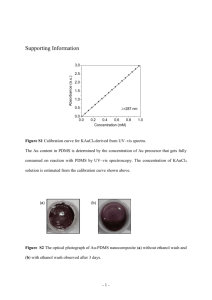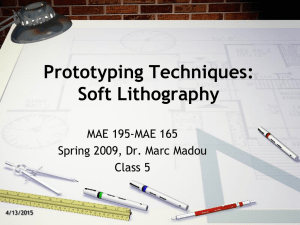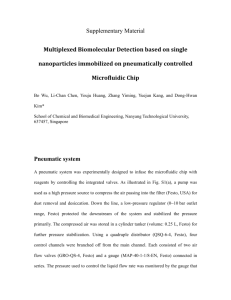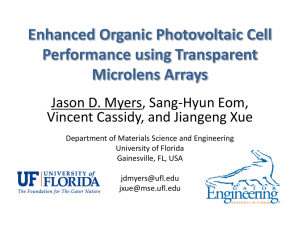Article - I
advertisement
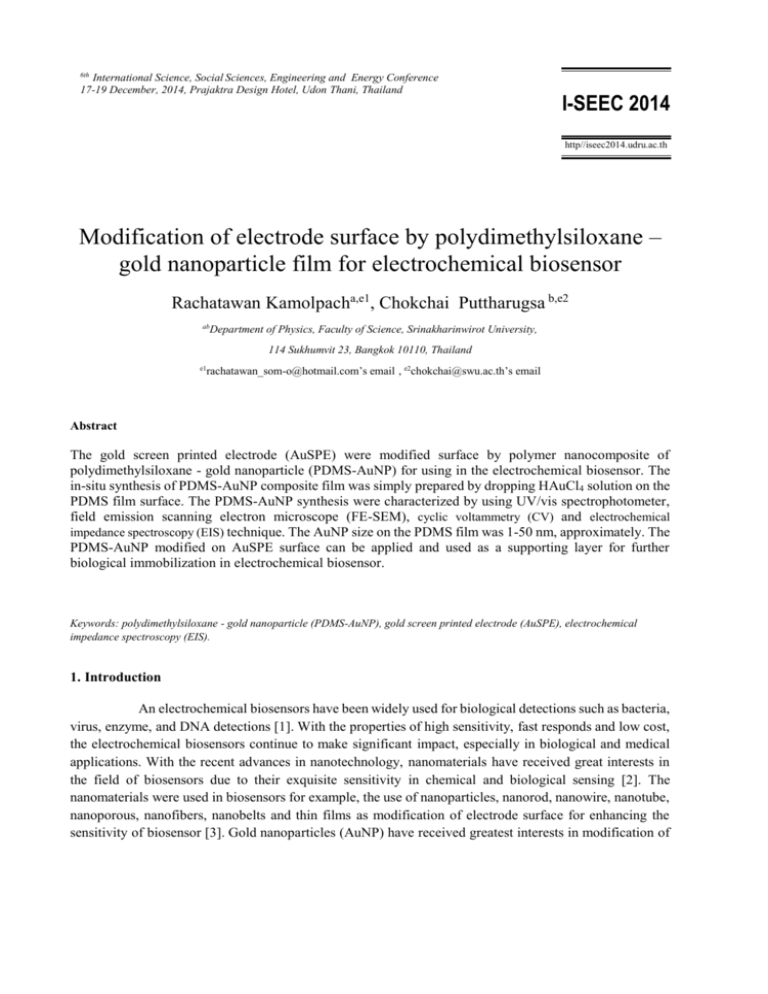
6th International Science, Social Sciences, Engineering and Energy Conference 17-19 December, 2014, Prajaktra Design Hotel, Udon Thani, Thailand I-SEEC 2014 http//iseec2014.udru.ac.th Modification of electrode surface by polydimethylsiloxane – gold nanoparticle film for electrochemical biosensor Rachatawan Kamolpacha,e1, Chokchai Puttharugsa b,e2 ab Department of Physics, Faculty of Science, Srinakharinwirot University, 114 Sukhumvit 23, Bangkok 10110, Thailand e1 rachatawan_som-o@hotmail.com’s email , e2chokchai@swu.ac.th’s email Abstract The gold screen printed electrode (AuSPE) were modified surface by polymer nanocomposite of polydimethylsiloxane - gold nanoparticle (PDMS-AuNP) for using in the electrochemical biosensor. The in-situ synthesis of PDMS-AuNP composite film was simply prepared by dropping HAuCl4 solution on the PDMS film surface. The PDMS-AuNP synthesis were characterized by using UV/vis spectrophotometer, field emission scanning electron microscope (FE-SEM), cyclic voltammetry (CV) and electrochemical impedance spectroscopy (EIS) technique. The AuNP size on the PDMS film was 1-50 nm, approximately. The PDMS-AuNP modified on AuSPE surface can be applied and used as a supporting layer for further biological immobilization in electrochemical biosensor. Keywords: polydimethylsiloxane - gold nanoparticle (PDMS-AuNP), gold screen printed electrode (AuSPE), electrochemical impedance spectroscopy (EIS). 1. Introduction An electrochemical biosensors have been widely used for biological detections such as bacteria, virus, enzyme, and DNA detections [1]. With the properties of high sensitivity, fast responds and low cost, the electrochemical biosensors continue to make significant impact, especially in biological and medical applications. With the recent advances in nanotechnology, nanomaterials have received great interests in the field of biosensors due to their exquisite sensitivity in chemical and biological sensing [2]. The nanomaterials were used in biosensors for example, the use of nanoparticles, nanorod, nanowire, nanotube, nanoporous, nanofibers, nanobelts and thin films as modification of electrode surface for enhancing the sensitivity of biosensor [3]. Gold nanoparticles (AuNP) have received greatest interests in modification of 2 electrode surface because they have several kinds of intriguing properties, such as a high surface-to-volume ratio with excellent biocompatibility, high sensitivity, and high stability [4-6] immobilization of a large amount of biomolecules retaining their bioactivity. Moreover, the modified electrode surface with AuNP has an advantages with providing fast and direct electron transfer between a wide range of electroactive species and electrode materials [7]. Poly(dimethylsiloxane) (PDMS) is one of the most widely used polymer materials for fabricating microfluidic chips due to its transparency, outstanding elasticity, good thermal and oxidative stability, ease to be fabricated and sealed with various materials [8,9]. In 2008, Qing Zhang and colleague presented a simple approach for in-situ synthesis of polydimethylsiloxane-gold nanoparticle (PDMS-AuNP) composite film [10]. They simply prepared the PDMS-AuNP by dropping gold salt on the PDMS. The gold ion can be reduced to AuNP using the remaining of curing agent. The size of AuNP can be simple controlled by adjusting the ratio of curing agent and the PDMS monomer. Moreover, the experiments have shown that the resulting composite film may have a lot of potential merits in protein immobilization, immunoassays and other biochemical analysis using PDMS-AuNP. In 2010, Pooja Devi and colleague, they are synthesis and surface modification of poly(dimethylsiloxane) – gold nano composite films used to study the binding of Human Serum Albumin (HSA) to polyclonal anti-HSA. Biosensing experiments carried out with the AuPDMS composite showed a good sensitivity allowing the detection of 2.5 g of antigen [11]. The method is suitable for microfluidic sensing applications for a variety of biomolecules. The same year, Wen-Ya Wu and colleague developed the colorimetric detection based PDMS-AuNP using silver enhancement for detection of cardiac troponin I [12]. The detection limit was 0.01 ng/ml. In the assay, antibody was immobilized on the PDMS-AuNP surface and bovine serum albumin was used as a blocking. The amount of antigen detection was relative to the darkness of silver deposition. Recently (in 2013), Hamid SadAbadi and colleague demonstrated the PDMS-AuNP microfluidic chip and used LSPR-based biosensor for detection of polypeptides [13]. The proposed biosensor can reach a detection limit of as low as 3.7 ng/ml. This results demonstrate the successful integration of PDMS-AuNP composite film based biosensors which provide a potential alternative for biological detection in applications. The main objective of this work is to synthesize the PDMS-AuNP nanocomposite film on the electrode surface. The major emphasize will be on the simply synthesis by dropping HAuCl4 on the coated PDMS surface and study effect of PDMS concentration and ratio between curing agent and monomer in PDMS. In addition, the PDMS-AuNP film were characterized by UV/vis spectroscopy and contact angle analysis. We expected that PDMS-AuNP coated AuSPE surface may be applied to electrochemical biosensor techniques for further development of biosensors with high sensitivity and stability. 2. Methodology 2.1. Materials Gold screen printed electrode (AuSPE) was purchased from DropSense (Spain). Detail of electrodes include a gold working electrode (disk-shaped, 12.6 mm2), a gold counter electrode, and a silver pseudoreference electrode. The electrodes are screen-printed on ceramic substrate and curing at low temperature. PDMS, silicone elastomer base and silicone elastomer curing agent, was purchased from Dow corning, Thailand. Potassium dihydrogen phosphate (KH2PO4), sodium acetate (CH3COONa·3H2O), di-sodium 3 acetate (CH3COONa.3H2O), sodium phosphate monobasic (NaH2PO4·H2O) and potassium chloride (KCl) were purchased from Caro erbe, Thailand 2.2. PDMS preparation and PDMS-AuNP synthesis PDMS was prepared by mixing the silicone elastomer base and elastomer curing agent at a ratio of 10:1.0 (w/w). The mixed PDMS was degassed and then diluted at different concentrations (0.1, 0.5, 1.0, 5.0, 10 and 20% w/v) in propane. The glass slides were cut in a piece of 1.0×1.0 cm 2 and were cleaned by rinsing with water, ethanol and dried with N2. For fabrication of PDMS film, the 100 µL of diluted PDMS solution was dropped on the glass substrate and was spun 1,000 rpm for 60 s by using a home-made spincoater. For PDMS-AuNP synthesis, 100 µL of 20 mg/ml HAuCL4 was dropped on the PDMS films with 24 h of incubation time. The PDMS-AuNP surfaces were characterized by using UV-vis spectrophotometer (Lambda 25 UV/vis spectrometer, Perkin Eimer istruments). The optimized PDMS concentration was further used in other optimized factors. The effect of incubation time, the optimum condition of PDMS concentration was used. 100 µL of 20 mg/ml HAuCL4 was dropped with different incubation times (2, 5, 8, 12, and 24 h). 2.3. Effect of ration The sized of gold nanoparticle was controlled by the ratio of silicone elastomer base and curing agent ().The ration were prepared in different ratio 10:0.6, 10:1, 10:1.5, 10:1.8, and 10:2 (w/w) denoted as = 0.6, 1, 1.5, 1.8, and 2. The PDMS-AuNP films were synthesized as mention above with different of PDMS. 2.4. Effect of HAuCl4 concentration HAuCl4 was diluted in deionized water (DI water) at different concentrations (1, 5, 10, 20 and 40 mg/mL). The optimized PDMS surface were selected for investigation in effect of HAuCl 4 concentrations. The different concentration of HAuCl4 (200 µL) were dropped and incubated on the optimized PDMS coated on glass substrate for 24 h. The PDMS-AuNP was then analyzed and characterized by UV-vis spectroscopy. 2.5. Effect of incubation time The 20 mg/ml of HAuCl4 was dropped and incubated on the optimized PDMS surface for 2, 5, 8, 12, and 24 h of incubation time. The synthesis of AuNP on PDMS surfaces were then characterized by mean of UV-vis spectroscopy. The information of optimized time, PDMS concentration, and HAuCl4 concentration was around 24 hours for 20% of PDMS incubated in 20 mg/ml of HAuCl4 for further preparation of AuNP-PDMS on the AuSPE surface. 2.6. CV and EIS measurement The AuSPE was cleaned by rinsing with DI water and dry with N2 gas. 10 µL of PDMS solution was dropped on the AuSPE surface and was spun at 1,000 rpm for 60 s. The PDMS film on AuSPE was 4 then cured at 60 degree for 30 min. The HAuCl4 was then dropped on the PDMS surface for synthesis of gold nanoparticle. The Cyclic voltammetry (CV) and electrochemical impedance spectroscopy (EIS) were used to characterize the film properties. CV and EIS were measured by using a µ-Autolab with FRA2 (ECO Chemie). All the experiment were carried out at room temperature (25 1 C). CV and EIS measurement were carried out in the presence of 5 mM [Fe(CN)6]3-/4- redox probe solution. CV was performed in the 0.25 to 0.5 V range at a scan rate 100 mV/s for monitoring PDMS and PDMS-AuNP film. Impedance measurement was recorded in range from 0.1 – 10,000 Hz of frequency. The alternating voltage was constant at 10 mV in amplitude. The impedance results were presented in a form of Nyquist plot. It plots between real part and imaginary part of resulted impedance. The Nyquist plots were fitted with proper equivalent circuit model using the facility of NOVA software v. 10.0 (ECO Chemie). 3. Results and discussion The UV-Visible absorption spectroscopy was used to monitor the surface plasmon absorption of gold nanoparticles. Figure 1 shows the UV-Vis spectra of the different PDMS films incubated with the HAuCl4 solution for 24 h. The synthesized gold nanoparticle appeared when the concentration of PDMS was greater than 5% w/v. The center of absorption band was 541–547 nm resulting from the surface plasmon band of gold nanoparticle [9]. The absorption intensity increased with concentration of PDMS, indicating the formation and increasing population of gold nanoparticles. Generally, the crosslink of PDMS is based on the reaction between silicon hydride (Si – H) group in the curing agent and vinyl group (Si – CH=CH2) in the monomer as shown in the equation 1. In cured PDMS, There are remaining of silicon hydride groups which are the precursors for synthesis of gold nanoparticle.The possibility of reaction between gold ion and silicon hydride groups has been suggested by Qing Zhang[10] as shown in the equation 2. This suggests that the population of gold nanoparticle depends on the amount of silicon hydride groups. Moreover, the 20% of PDMS concentration showed the highest peak absorbance due to the high amount of residue silicon hydride group on the surface. Figure 2 shows the schematic of PDMS-AuNP synthesis. (1) (2) Figure 2. Schematic of PDMS-AuNP synthesis. Figure 1. UV-Visible spectra of different concentration incubated in 20 mg/mL of HAuCl4 solution 24h. 5 Figure 3 shows the difference of incubation time for synthesis of PDMS-AuNP. The adsorption intensity increased with incubation time and reached saturation at 12 h. This indicate that the formation and population of gold nanoparticle was appeared on the PDMS film. Due to the thin layer of PDMS on the surface, the amount of synthesized gold nanoparticle is limited by the amount of remaining of curing agent. The dependency of absorbance resulting from the different HAuCl4 concentrations is shown in figure4. The absorbance peak (𝜆max = 539) increased with proportional to the HAuCl4 concentration. At 20 mg/ml of concentration, the absorbance peak was maximum for the synthesis of gold nanoparticle. This suggests that this concentration is suitable or have high enough concentration for further synthesis of PDMS-AuNP on the surface. Figure 3. UV-Visible spectra of different time incubated Figure 4. UV-Visible spectra of different concentration in 20 mg/mL of HAuCl4 solution for 20% PDMS surface. . HAuCl4 in 20% PDMS surface for 24 h of incubation time. Figure 5 shows the difference of in which the PDMS surface was immersed in 20 mg/mL HAuCl4 aqueous solution for 24 h of incubation time. The differences of can also be observed in the UV-Vis spectra. The maximum absorption peak shifts from 538 nm to 540 nm, with the increase of from 0.06 to 0.2. The was increase yielding the more residual Si–H groups existed on the PDMS surface. These Si–H groups can be quickly react with AuCl-4 anions on the surface and becomes nanoparticles. The difference of affect the particle size see from the shifts of maximum absorption peak. Figure 6 shows the FE-SEM image of PDMS-AuNP in different ration. This ration has a great effect on the shape and size of the gold nanoparticles as seen in figure 6. When was 0.1 (fig.6a), the size of AuNP average of about 1-200 nm in range, approximately. The shape of most nanoparticles seemed to be round. When was 0.15 (fig.6b), the size of AuNP the average of about 10-400 nm in range, approximately. The nanoparticle shape was changed to polygonal, including triangles, ellipses, pentagons and hexagons. Figure 5. UV-Visible spectra of different incubated in 20 mg/mL of HAuCl4 solution for 24 h. Figure 6. FE-SEM images of the PDMS–gold nanoparticles free-standing films with (a) =0.1, (b) =0.15 6 The PDMS and PDMS-AuNP films were monitored by using EIS and CV technique. Figure 7 shows cyclic voltammogram using the 5 mM of [Fe(CN)63−]/[Fe(CN)64−] solution as a redox probe. The working electrode modification with a 20% PDMS resulted in a decrease in the peak current as shown in figure 7 (red line). The current peak also increased in the separation of the peak potentials (red line) when compared to the CV of an unmodified electrode (AuSPE, black line). The decrease of peak current depend on the concentration of PDSM on the electrode surface (data do not shown). At 20% PDMS, the current peak was disappear. This results indicate that the PDMS film was impede the electron transfer between working and counter electrode. After drop of 20 mg/mL HAuCl4 on a 20% PDMS surface for 24 h, the gold nanoparticle was then formed on the PDMS surface. The reduction of current peak was thus increase as shown in figure 7 (blue line) and was about 24 µA due to the formation of AuNP. Figure 8 shows the obtained Nyquist plots for concentration of PDMS and the inset shows the Randle circuit model. The Nyquist plot was fitted by using Randle circuit model to obtain the electron transfer resistance (Ret). The Ret depends on the dielectric at the interface of electrode. The Ret is very sensitive to the electrode surface modified with PDMS layer. In Figure 8, the bare AuSPE showed the fast electron transfer. After drop difference concentrations of PDMS on working electrode surface, the value of Ret was increase due to the layer of PDMS impeding the electron transfer (data do not shown). The Ret of 20% PDMS on the AuSPE electrode was 14 kΩ. After drop of 20 mg/mL HAuCl4 on PDMS, the Ret was decrease to 680Ω by the reason of AuNP formation and resulted in a good electron transfer between working and counter electrode. The results of Nyquist plot are also consistent with the cyclic voltammogram observed in the CV measurement. These results indicate that the AuNP can promote the electron transfer between that electrodes. Figure 7 Cyclic voltammogram. Figure 8 Nyquist plot 4. Conclusions The nanocomposite film of PDMS-AuNP was successfully prepared by a simply drop of HAuCl4 solution on PDMS film surface. In application of electrochemical sensor, the suitable condition for PDMSAuNP synthesis was 20 mg/ml of HAuCl4 incubated on the 20% of PDMS (=0.1) coated on surface for 24 h. The size of synthesized AuNP on the PDMS surface was 1-50 nm in range. The PDMS-AuNP nanocomposite films on AuSPE can be applied in biosensor techniques for further development of EIS biosensors in order to enhance the sensitivity and stability.Acknowledgements 7 The author would like to thank the financial support by Faculty of Science and Graduate School at Srinakharinwirot University. References [1] V. E. Gomez, S. Campuzano, M. Pedrero, and J.M. Pingarron. Gold screen-printed-based impedimetric immunobiosensors for direct and sensitive Escherichia coli quantization. Biosens. Bioelectron 2009;24:3365-3371. [2] K.K Jain. Nanodiagnostics:Application of nanotechnology in molecular diagnostics. Expert Rev. Mol. Diagn 2003;3:153-161. [3] R. A. S. Luz, R. M. Iost and F. N. Crespilho. Nanomaterials for Biosensors and Implantable Biodevices. F. N. Crespilho (ed.). Nanobioelectrochemistry, DOI: 10.1007/978-3-642-29250-7_2; 2013, p. 27-48. [4] J. Wang, R. Polsky and D. Xu. Silver-enhanced colloidal gold electrochemical strip-ping detection of DNA hybridization. Lang muir 2001;17:5739-5741. [5] J. Wang, D. Xu, R. Polsky, J. Am. Magnetically-Induced Solid-State Electrochemical Detection of DNA Hybridization. Chem. Soc 2002;124:4208-4209. [6] C. N. R. Rao, G. U. Kullkarni, P. J. Thomasa, and P. P. Edwards. Metal nanoparticles and their assemblies. Chem. Soc. Rev 2000; 29:27-35. [7] Y. Lia, H. J. Schluesenerb and S. Xu. Gold nanoparticle-based biosensors. Gold Bulletin 2010;43:29-41. [8] S.K. Sia and G.M. Whitesides. Microfluidic devices fabricated in poly(dimethylsiloxane) for biological studies. Electrophoresis 2003;24:3563-3576. [9] M. JC, and W. GM. Poly(dimethylsiloxane) as a material for fabricating microfluidic devices. Acc Chem Res 2002;35:491-9. [10] Q. Zhang, J.-Juan Xu, Y. Liu, and H.-Yuan Chen. In-situ synthesis of poly(dimethylsiloxane)-gold nanoparticles composite films and its application in microfluidic systems. Lab chip 2008;8:352-357. [11] P. Devi, A. Yahya Mahmoud, S. Badilescu, M. Packirisamy, P. Jeevanandam, and V.-Van Truong. Synthesis and Surface Modification of Poly(dimethylsiloxane) – Gold Nanocomposite Films for Biosensing Applications. BioSciencesWorld 2010;28:1-5. [12] W.-Ya Wu, Z.-Ping Bian, W. Wang, and J.-Jie Zhu. PDMS gold nanoparticle composite film-based silver enhanced colorimetric detection of cardiac troponin I. Sens. Actuators B 2010;147:298-303. [13] H. SadAbadi, S. Badilescu, M. Packirisamy, and R. Wuthrich, Integration of gold nanoparticles in PDMS microfluidics for labon-a-chip plasmonic biosensing of growth hormones, Biosens. Bioelectron 44 (2013) 77-84.
